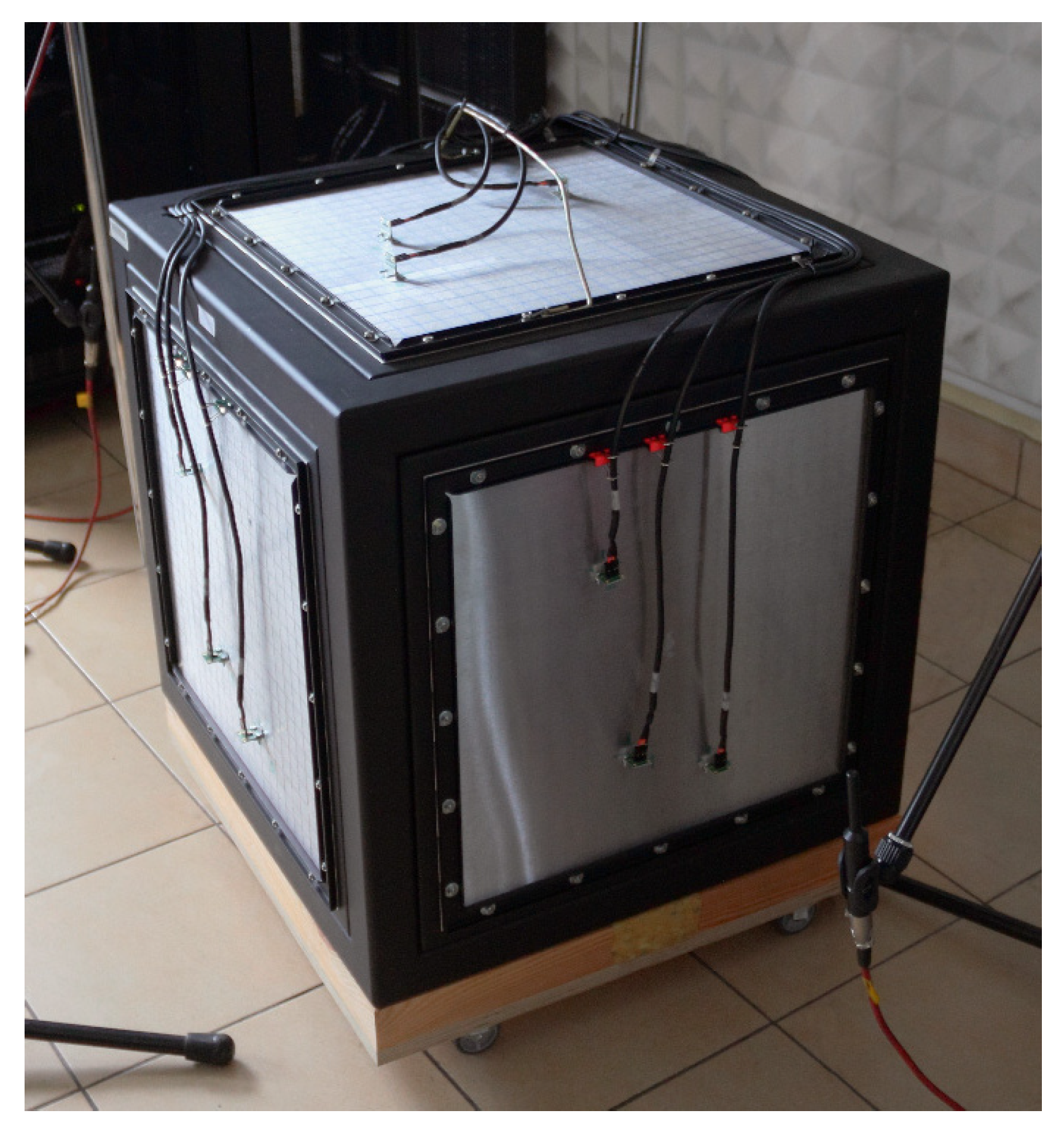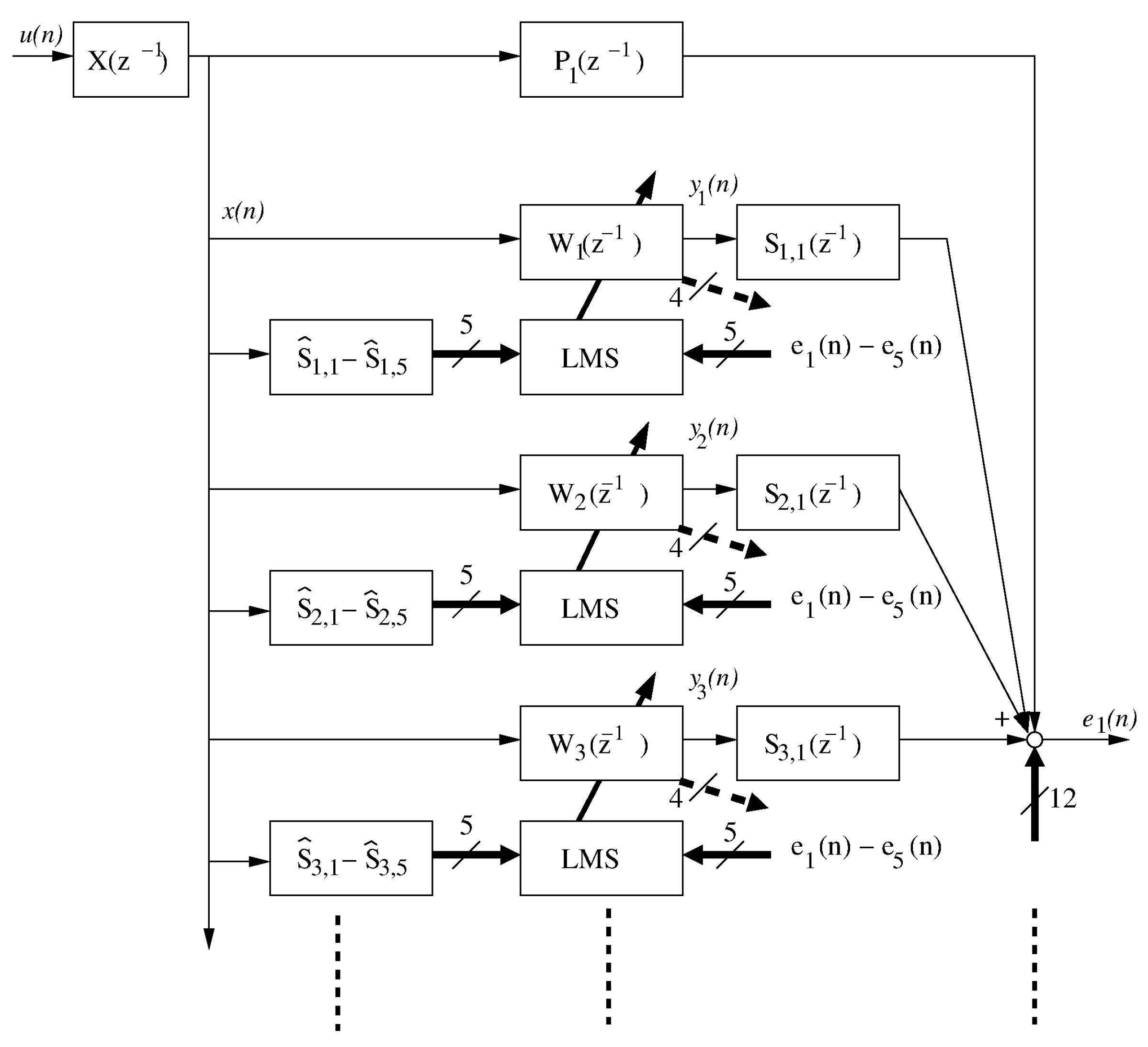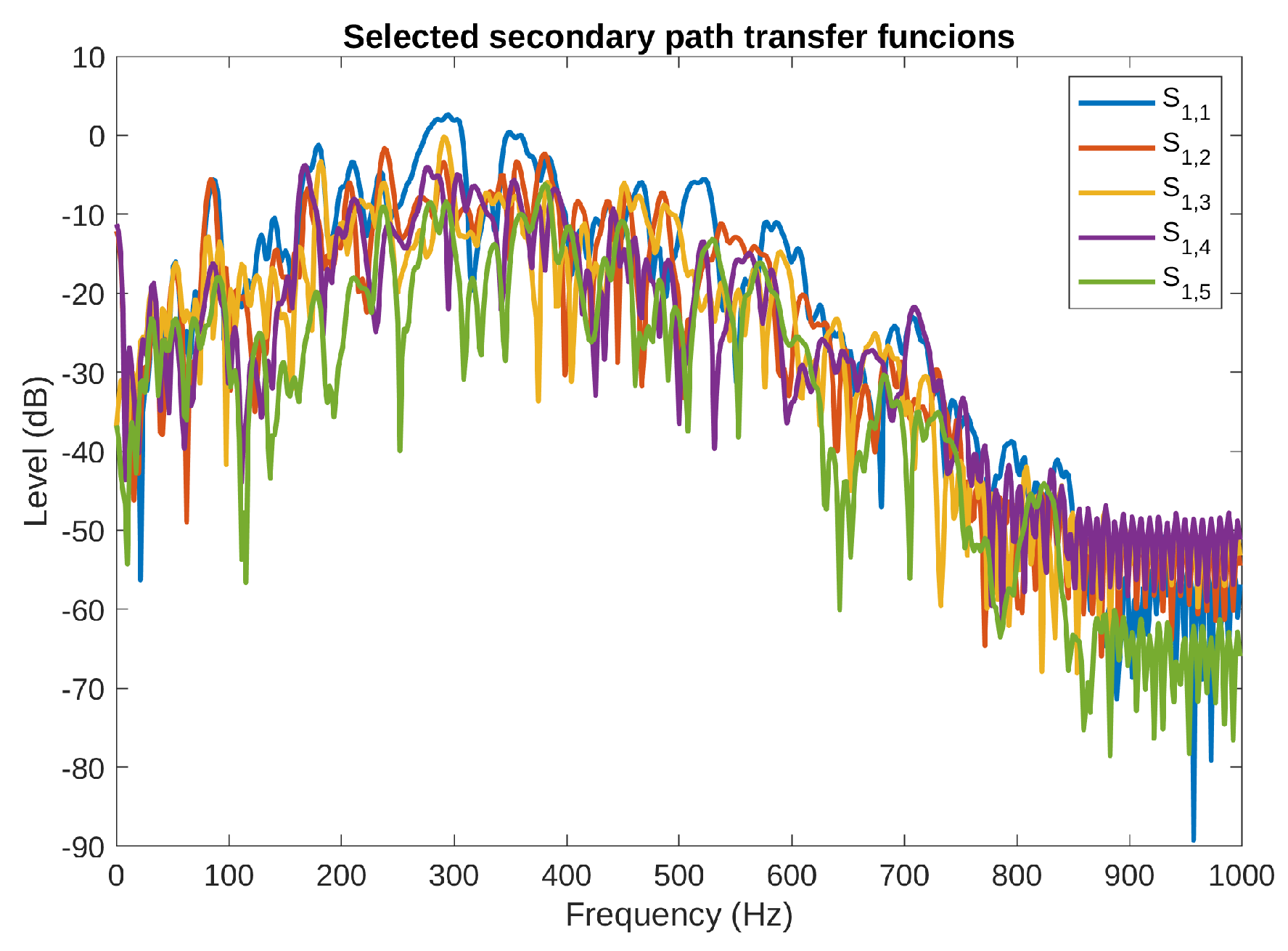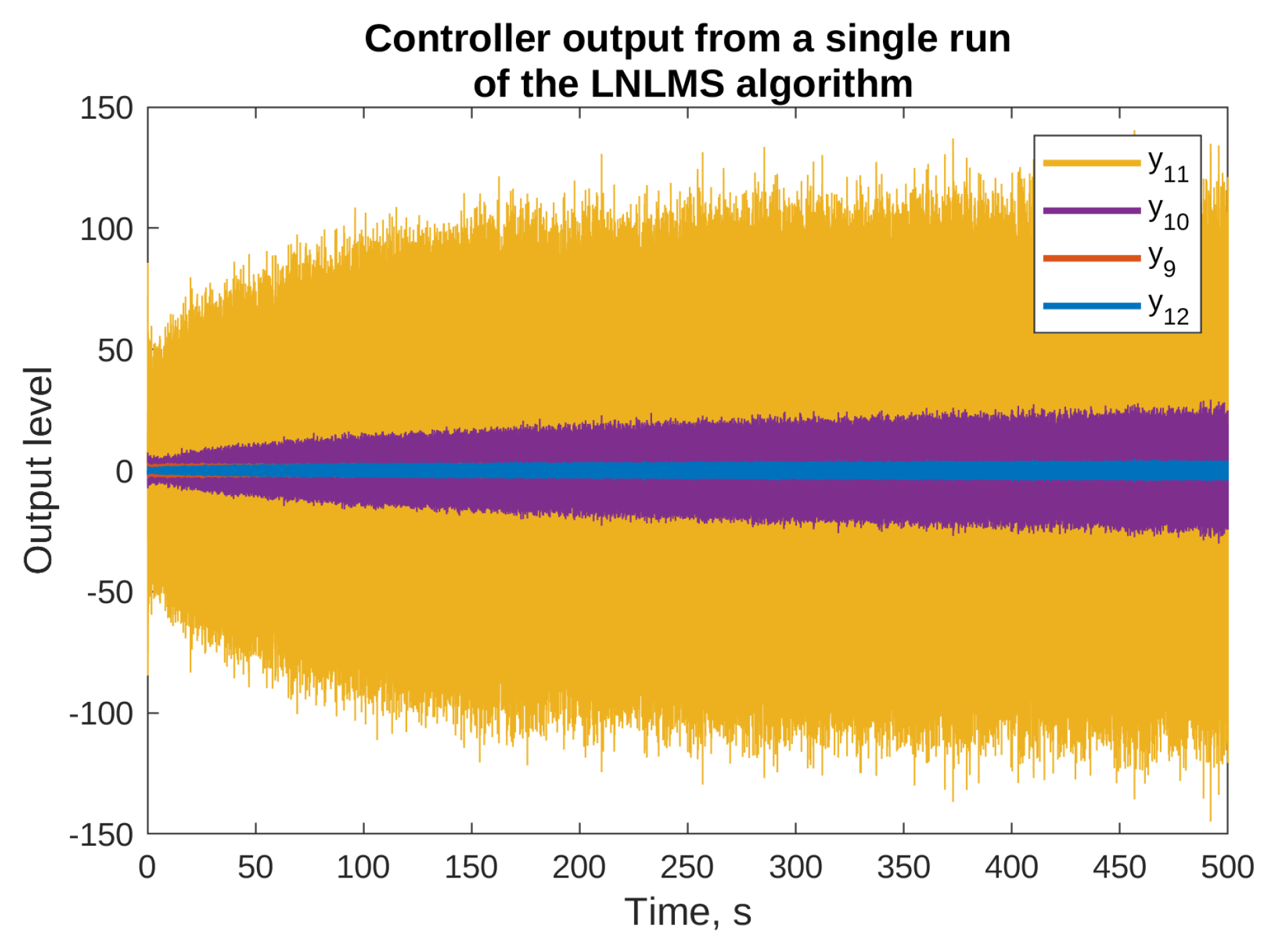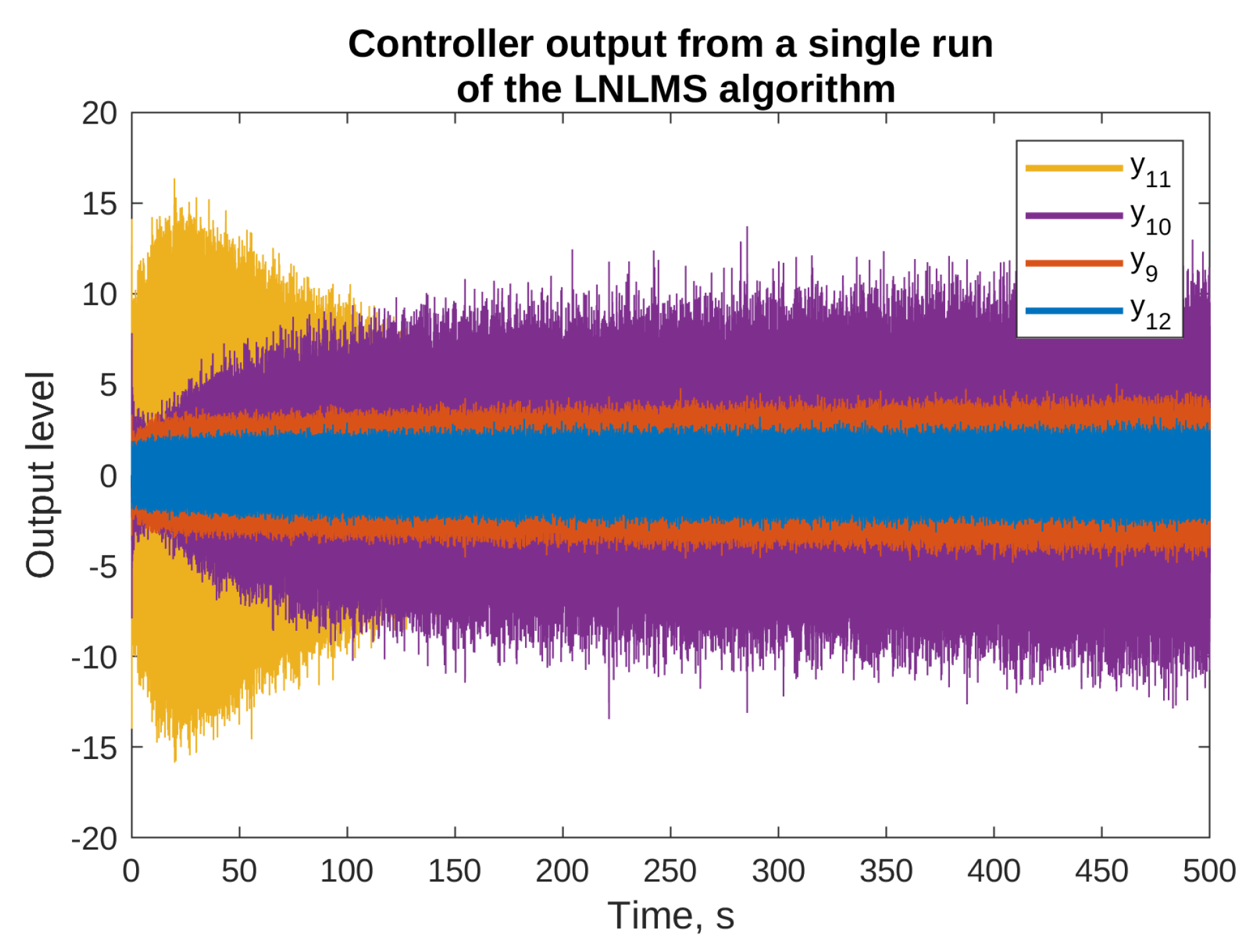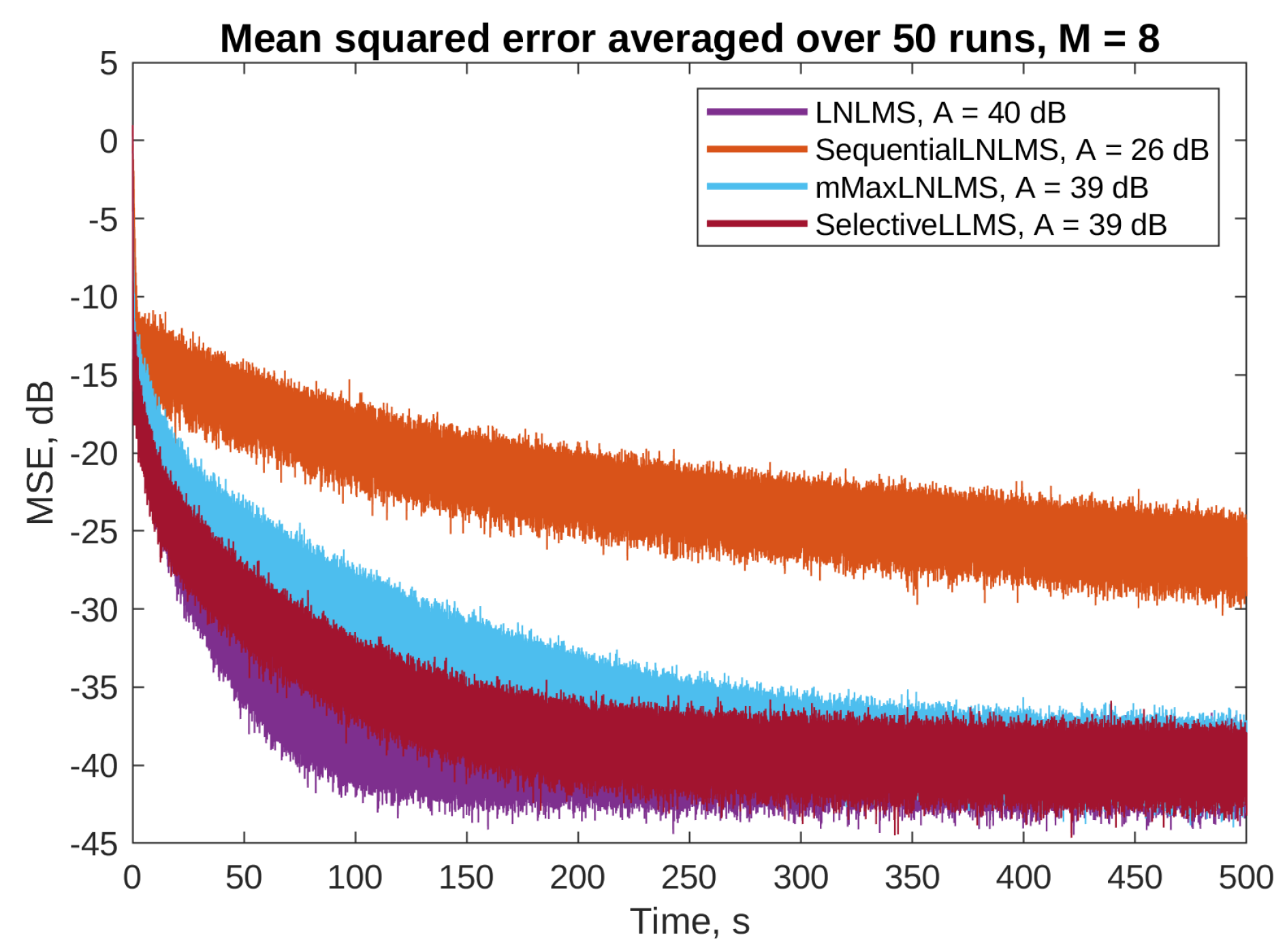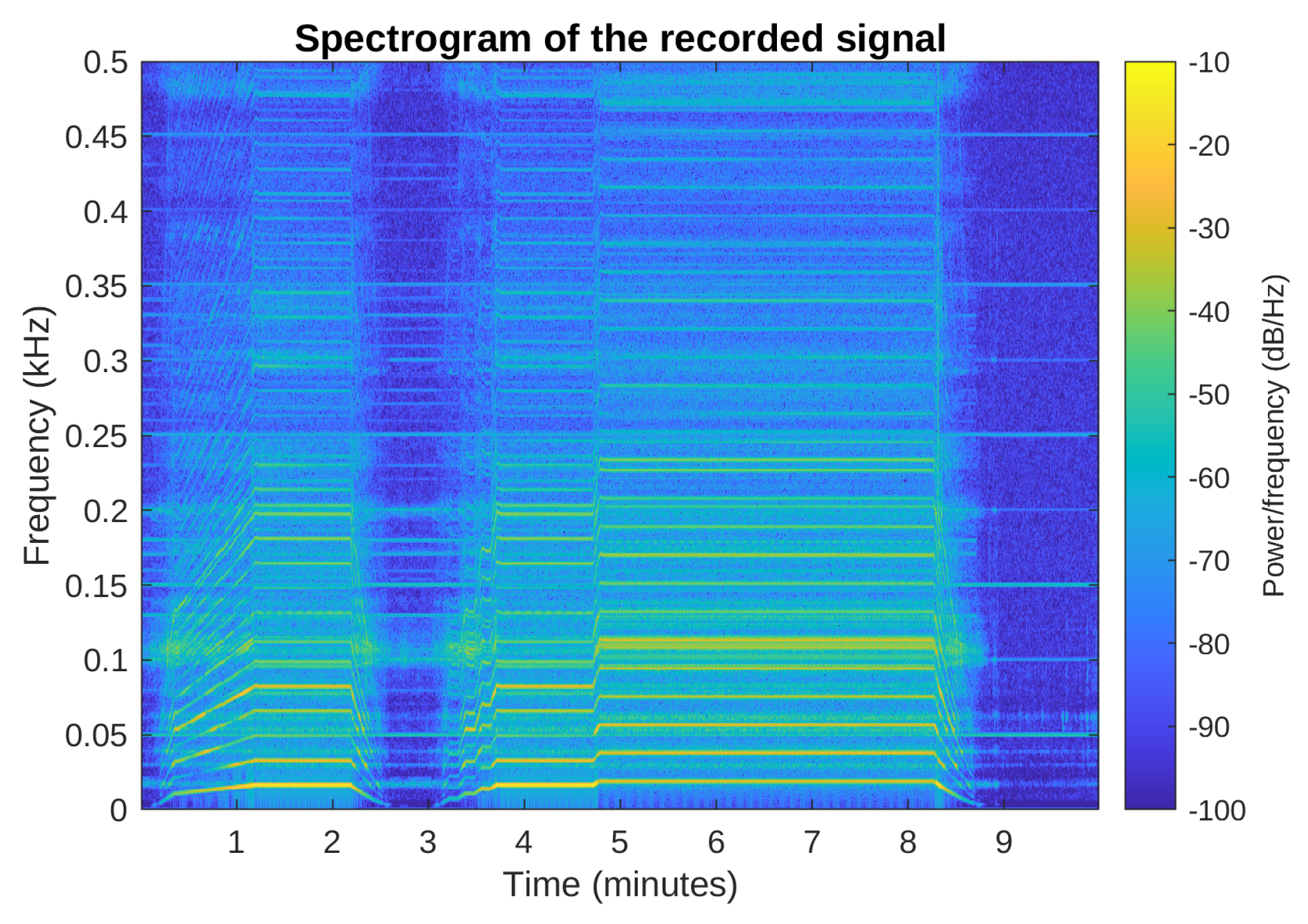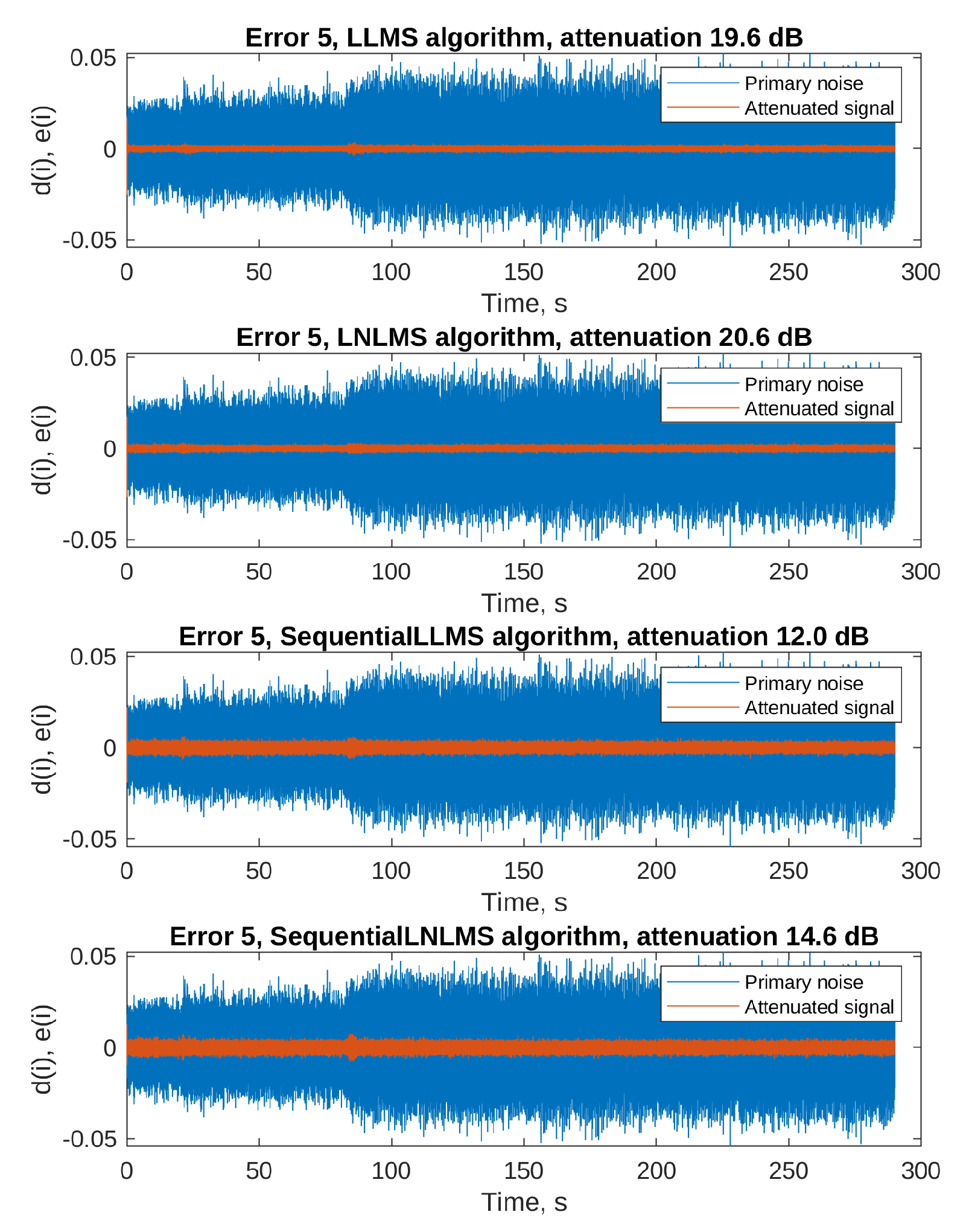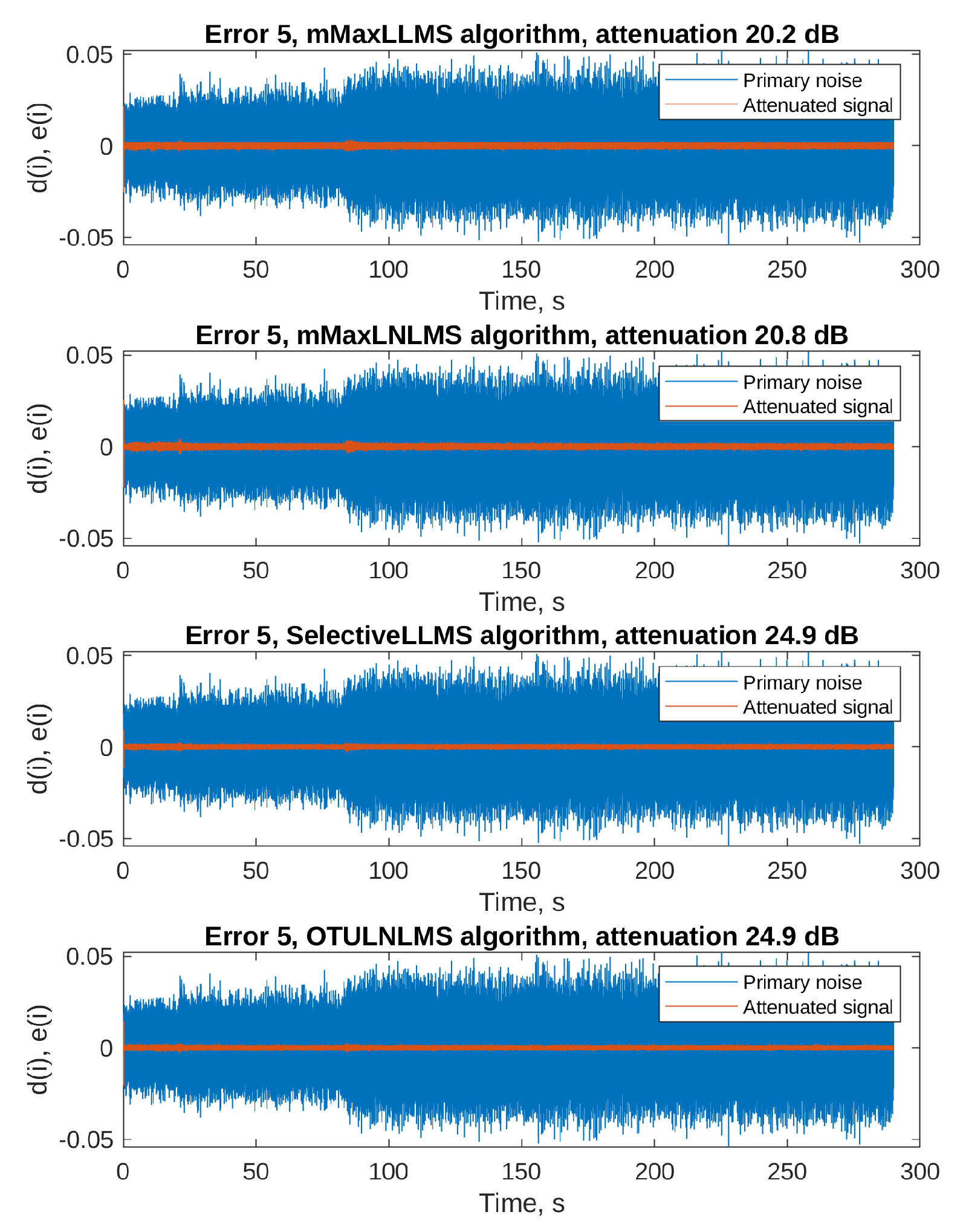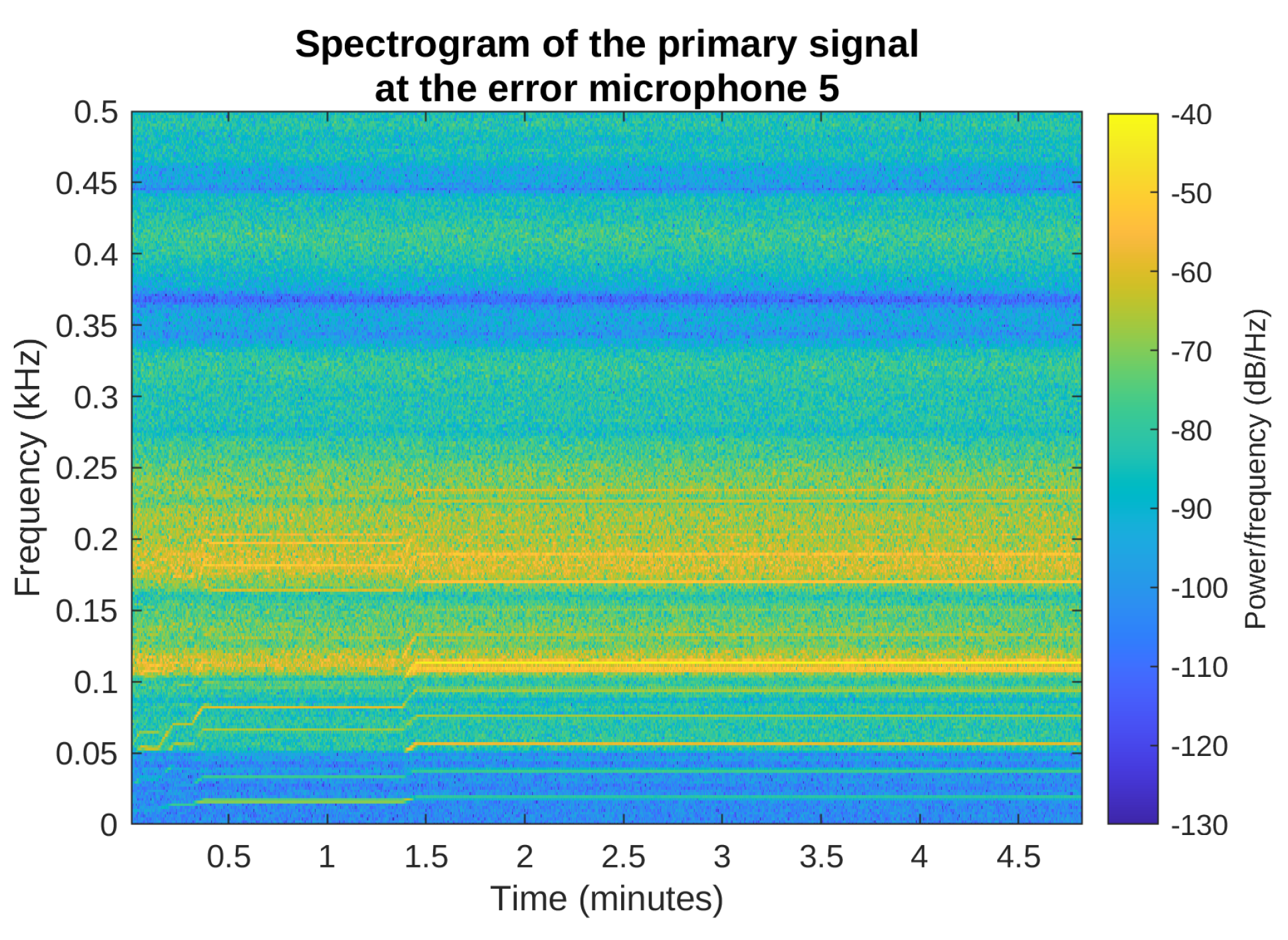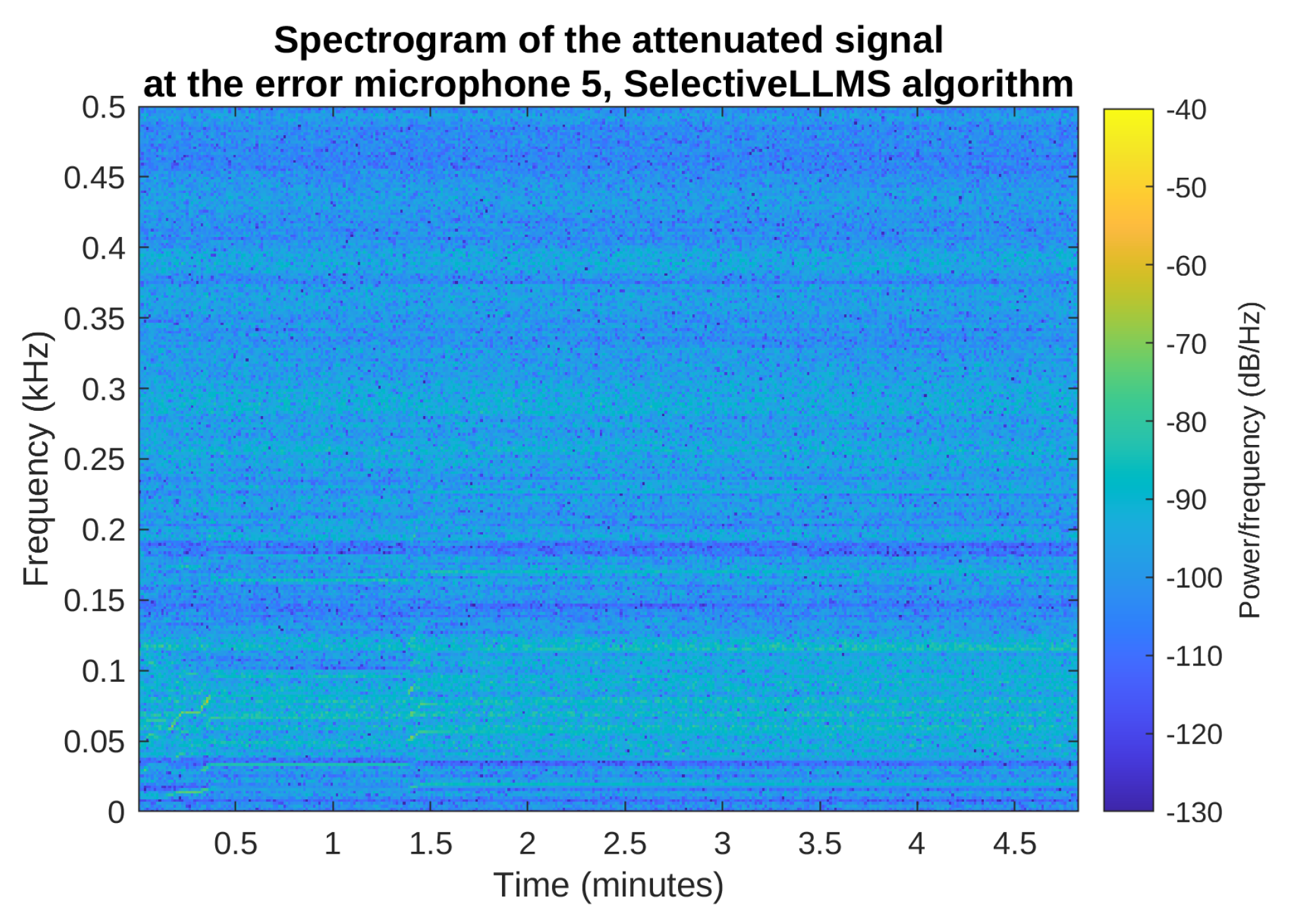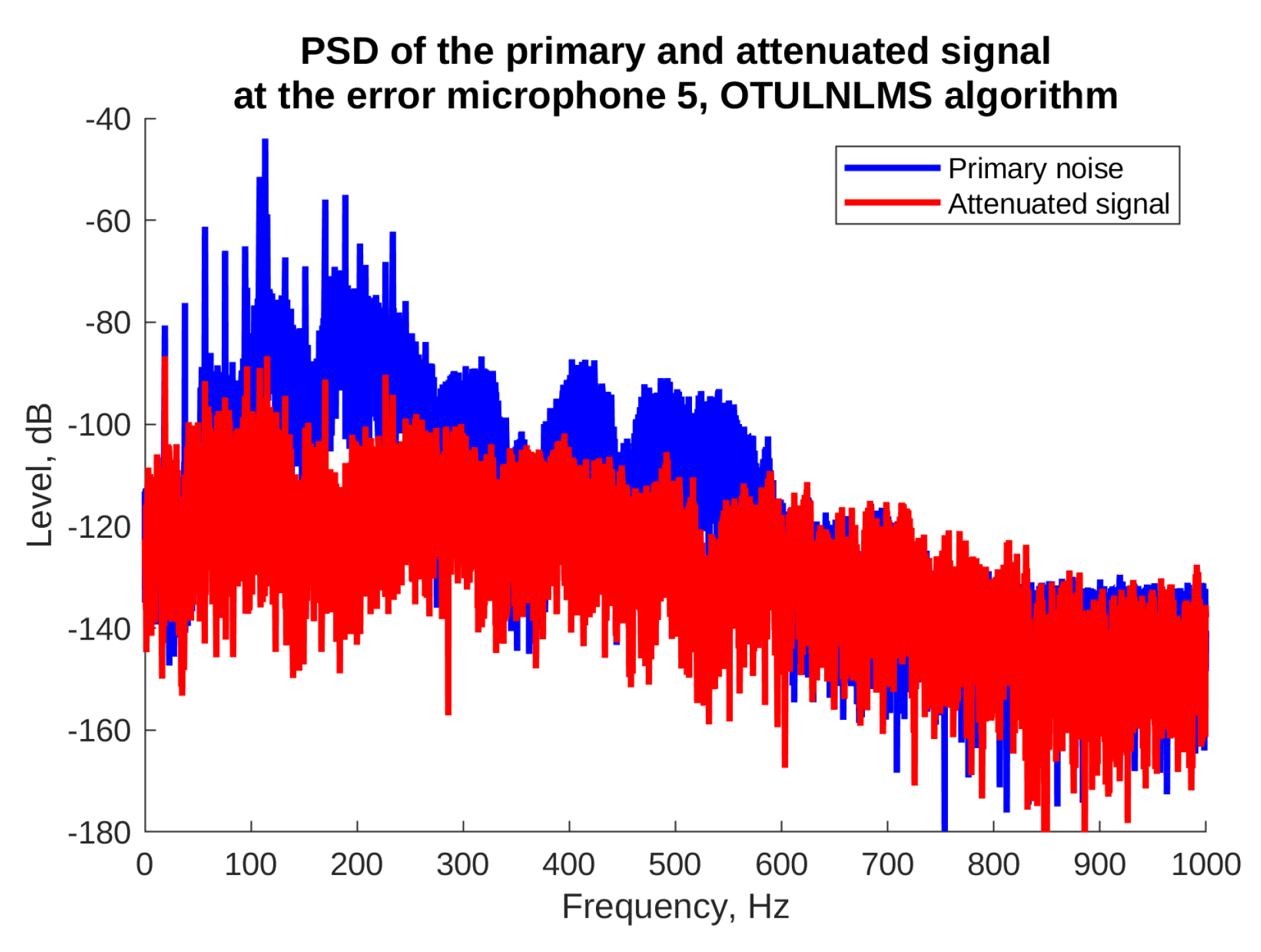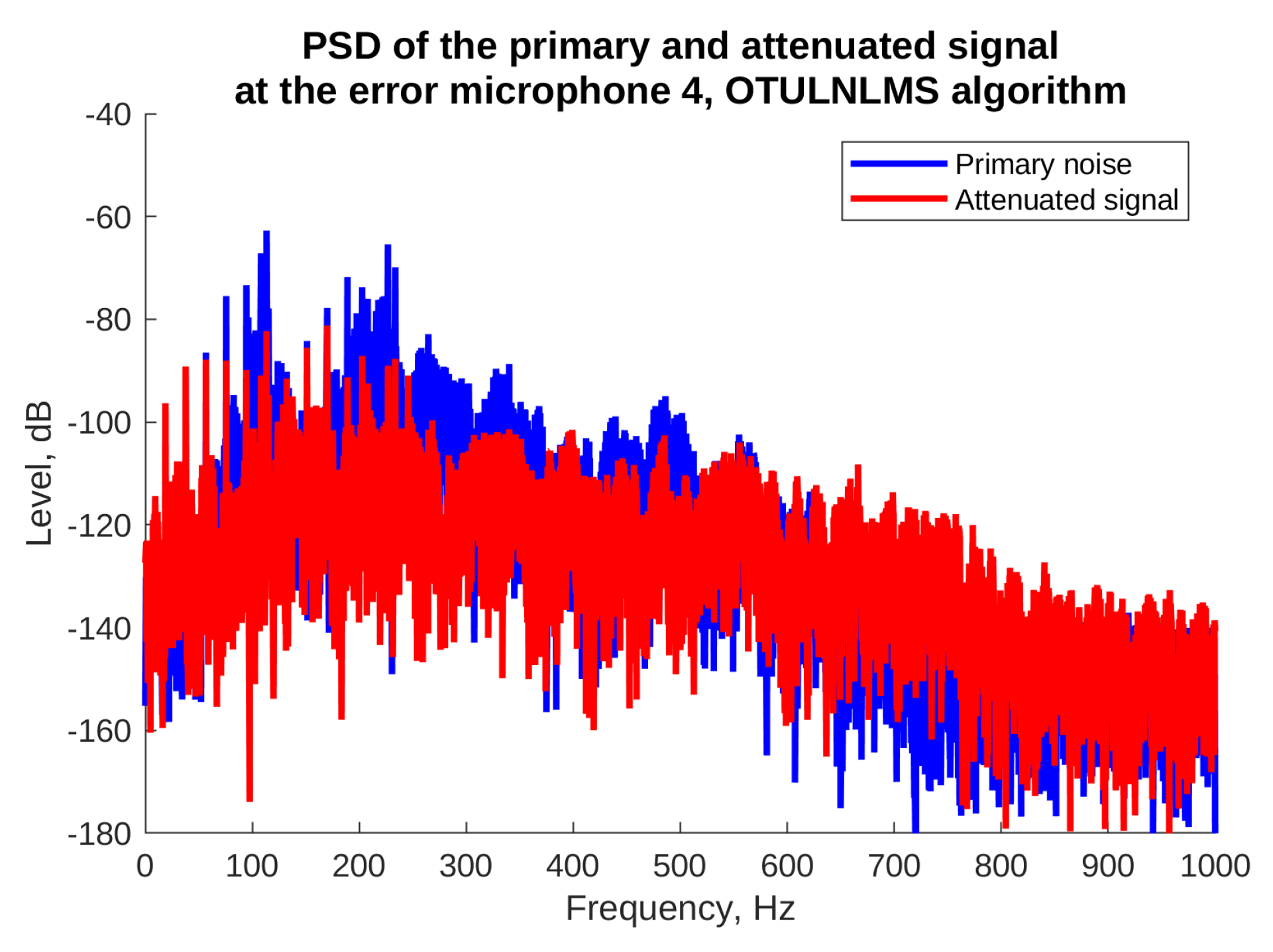Structural ANC systems are the systems that apply active control to the noise-emitting structure rather than to an additional loudspeaker [
22,
23]. These methods have earned a lot of attention among the scientific community due to the fact that they allow to achieve a global noise reduction, hard to obtain using different methods [
24,
25]. Unfortunately, structural ANC belongs to the group of the most demanding algorithms, when it comes to the computational power [
19]. This is due to the fact that controlling even a simple structure usually requires more than one sensor and actuator, even if the structure is only a single panel or wall. To present a more realistic example, consider a system controlling the noise propagating from a device with a cuboid enclosure. The numbers of walls to control differs from 3 (for the device positioned in a corner of a room) to 5 (for the device standing far from the walls of a room). Suppose the device is positioned close to a wall (but not in a corner), so that 4 devices walls are to be controlled, and each is controlled using 4 actuators. Suppose there are 5 error sensors in the room—the number of active filters to consider will be equal to 80 (4 walls times 4 actuators times 5 error sensors). The hardware demands of such a multichannel system operating with a reasonable sampling frequency and even short filter lengths (e.g., 128) are enormous; therefore, only adaptation algorithms with low computational power demands can be considered for such a case and the alike. Partial updates belong to the group of such algorithms, and we will demonstrate by the means of simulations that leaky PU LMS algorithms can be successfully used.
Several techniques can be used to lower the computational demand. The most intuitive way is to use shorter adaptive filters, but this attitude may result in poor attenuation results for noises more complicated than sinusoidal signals. Another attitude is to use a computational power saving algorithm. There are a few such algorithms, e.g., the switched error algorithm [
26]; however, the partial updates can also be used, as reported in previous research [
4,
7] and this communication. Two experimental setups, based on existing, real laboratory stands, will be used to demonstrate by simulations that PU algorithms with leakage are particularly well-suited for structural ANC.
4.1. Experimental Setup 1: Active Casing
The first experimental setup consists of an active casing with rigid corners and 1 mm thick aluminum plates, with 420 × 420 mm dimensions, as presented in
Figure 1. Each plate was equipped with three electrodynamic Monacor EX-1 5 Watt actuators, mounted in carefully selected positions to improve controllability of the system. The casing was placed in the laboratory room a little distance off the walls so five sides of the casing were available and an error sensor (microphone) was positioned in front of each side [
22].
The above setup consists of 15 actuators and 5 error microphones; thus, the number of secondary paths to consider is 75. The models of those secondary paths were identified in the form of finite impulse response (FIR) filters with 256 parameters. The identification experiments were performed using white noise as an excitation and using the sampling frequency of 2 kHz. In addition, a loudspeaker was placed inside the casing and the primary paths were identified as well, in the same form. Finally, a reference signal path was identified between the loudspeaker and a microphone placed inside the casing.
The identified transfer functions (TF) were used to design a simulation system allowing for rapid testing of adaptation algorithms. A part of the block diagram of this system, associated with one of the casing walls, is presented in
Figure 2. According to this figure, the noise to be attenuated
is filtered through the reference path TF
, to produce the reference signal,
. The reference signal forms the input to the primary path TF
, where
j is the corresponding error microphone number. This reference signal forms the input signal to the control filters—three such filters,
, and
, associated with the front plate are presented in
Figure 2. Each control filter produces the output
, which is then filtered with five different secondary path TFs; one of these TFs for each of the presented filters is visible in the figure. The secondary path TFs are denoted as
, where
i is the actuator number (
), and
j is again the error microphone number. Three secondary path TFs, i.e.,
,
, and
, are presented in
Figure 2, while the remaining twelve belong to the other error signal paths. In consequence, each error signal is a sum of 16 signals: one primary signal and 15 signals coming from the 15 actuators.
All 5 error signals are used by each of the adaptation algorithms, denoted as LMS in
Figure 2 [
18,
27]. In addition, each of the adaptation algorithms uses 5 reference signals, each filtered through a different secondary path TF estimate, e.g.,
–
in case of the algorithm associated with the
control filter. The simulation system is then fairly advanced and requires 165 filtrations and 15 adaptations in each simulation iteration.
Exemplary frequency characteristics of the secondary path TFs from one of the actuators mounted on the front plate to all the five error microphones are illustrated in
Figure 3. From the figure, it can be noticed that the magnitude of the presented TFs is similar in the average; however, large variations of magnitude for all the five TFs are observed at several particular frequencies. For example,
and
have a very low magnitude at 115 Hz, the difference between
and
is around 40 dB at this frequency.
Figure 4 presents the frequency characteristics of the secondary path TFs from the three top plate actuators to one of the error microphones. In this case, the magnitudes of the presented TFs differ much more from each other than those presented in
Figure 3. Moreover, similar differences were observed for the TFs to the other four error microphones. Special attention should be paid to the
TF, which has the lowest average magnitude among all the secondary path TFs.
Both the above mentioned figures suggest that the identified models are accurate and contain a variety of phenomena present in real environment, contrary to some other, simplified models (e.g., TF of 16 order) used in simulations presented in the literature. Moreover, the secondary path TF estimates (
in
Figure 2) used in the simulations presented below were not perfect. Instead, all the models were truncated down to 128 parameters, and each impulse response parameter was disturbed with a small, random value.
The simulations described in this section, unless otherwise specified, were performed using the following setup. The sampling frequency was assumed to be 2 kHz. The noise signal was generated as a sum of two sinusoids, with frequencies 112 and 191 Hz, shifted in phase by . A white noise sequence was also generated of the same length and was filtered with a band-pass filter with pass band between 100 and 500 Hz, resulting with a sequence for which the variance was equal to 0.4. Such noise was added to the two-sine signals to present a more realistic signal. The active filter length was set at 256. Three different step sizes were used: 1 × for the algorithms with a constant step size, 8 × for the algorithms with the step size normalization, except for the selective LLMS (including the One Tap Update LLMS), for which the step size was equal to 4 ×. The leakage factor used was 0.999999, except for the eleventh active filter—the filter associated with the second sensor on the top plate—for which the leakage factor was 0.99999. The step sizes and leakage factors were determined by trial and error, with an intention to achieve fast adaptation and robust performance (the robust performance was confirmed by simulation of combinations of different frequencies, within the band 100–300 Hz). The simulations were repeated 50 times, with different white noise sequences, to achieve smoother mean square error (MSE) curves.
4.2. Simulation Results
The reasons for using the algorithms with leakage are presented in
Figure 5 and
Figure 6, where the results of simulation of the NLMS algorithm without leakage are presented. The figures present the output signals from the adaptive filters only (the final attenuation towards the end of this simulation was around 37 dB). From the figures, it is clear that some of the output signals have substantially higher levels than the others. For example,
output level reaches
,
output stays within
, and
exceeds
. On the other hands, the majority of signals are bounded by
. It can be also noticed that some of the signals did not achieve a steady state even after 500 s of the simulation, and are still growing slowly. Both the facts suggest that the described algorithm without leakage is not suitable for practical applications, because it would probably result in exceeding the digital-to-analog converters limits, and it would probably be unstable after longer periods of operation. Therefore, all the remaining simulations presented in this paper use algorithms with leakage.
The results also suggest that a lower value of the leakage should be applied for those filters that give higher output values. Unfortunately, particular values of the leakage factor are hard to determine in a way other than by trial end error. In practical ANC applications, this is usually done based on observation of the filter parameters, which should be approximately constant in the steady state.
Figure 7 and
Figure 8 present the mean squared error (MSE) obtained on the selected error microphones during simulations of algorithms without and with the step size normalization, respectively. The PU algorithms were simulated with
, i.e., 16 adaptive filter parameters out of 256 were updated in each simulation step. The full update LLMS and LNLMS algorithms were added to the simulations for a reference. The attenuation level was calculated based on the MSE during the last 50 s of each simulation.
The figures show that all the algorithms are stable and converge at different speeds, reaching noticeable attenuation levels towards the end of the simulation. Among the algorithms without the step size normalization (
Figure 7), the full update algorithm is the fastest to converge, and attains the highest level of attenuation; however, the M-max LLMS algorithm converges only a little slower, and attains the same level of attenuation. The sequential LLMS algorithm converges very slowly (approximately 16 times slower); therefore, it achieves only 24 dB of attenuation within the simulation window.
The algorithms with the step-size normalization (
Figure 8) are capable of achieving even better performance: converge faster and achieve higher levels of attenuation. It is interesting to notice that all the PU algorithms except the sequential LNLMS algorithm show similar performance than the full update LNLMS. The selective LNLMS algorithm shows the fastest initial convergence speed and attains an attenuation level only slightly worse than the full update. However, the OTU LNLMS algorithm is the third, reaching an impressive attenuation level of 36 dB despite the fact that it updates only one filter weight in each simulation step.
The final attenuation levels obtained for all five error microphones for all the simulated algorithms are presented in
Table 2. From the table, it is clear that the attenuation level calculated based on
was the best, while the attenuation for
was the worst. The latter fact can be explained based on the geometry of the laboratory, where the fifth microphone, corresponding to the back panel, was close to the room wall.
Figure 9 presents selected output signals obtained during simulation of the LNLMS algorithm, corresponding to those in
Figure 6. It can be observed that introduction of the leakage prevented the output signals from reaching very high levels—this fact is especially visible in case of
.
Figure 10 and
Table 3 present the results of simulations with
(eight filter taps updated in each simulation step). The figure shows only the algorithms with the step size normalization, which show better performance. The table does not include the algorithms which do not use the
M parameter (i.e., full update algorithms and the OTU LNLMS). It can be noticed that updating only eight parameters results in slightly worse performance, compared to simulations with
, but the results are still acceptable in the means of both the convergence speed and the attenuation level.
4.3. Experimental Setup 2: Washing Machine
The second experimental setup uses a commercial washing machine, as presented in
Figure 11. The device was placed in the laboratory close to one of the walls; therefore, only four walls of the machine were available. Thirteen 5 W electrodynamic actuators were placed on the machine: three on each of the three side walls and four on the top wall (contrary to the Figure, which was taken before the final mount). The reference sensor was placed inside the washing machine, below the drum. The laboratory room was equipped with eight microphones, positioned in a quarter-sphere arrangement, used as error sensors (the final application will probably use other type of sensors, e.g., accelerometers attached to the device, and using the Virtual Microphone technique [
28]). As was described in [
22], examination of the results of attenuation on the eight error microphones allows us to determine the global attenuation effect.
Similar to the case of the first experimental setup, impulse responses of primary and secondary paths were identified, each with 256 parameter. There were eight primary paths from the reference microphone to the error sensors, and 104 secondary paths, from the 13 actuators to each of the error sensors. The same sampling frequency of 2 kHz was used. Again, the simulation system was implemented in the Matlab environment with the block diagram similar to this presented in
Figure 2. This system was used to produce the results presented below.
The simulations were performed using a signal recorded during the washing machine spinning cycle, which is the loudest part of each washing. The spectrogram of this signal is presented in
Figure 12, where the variety of the spinning signal harmonic components can be observed. For example, the spinning frequency is constant and equal to 1140 rpm between 5th and 8th minute of the cycle; therefore, the 19 Hz component and its products are easily distinguishable. Nevertheless, it should be noted that the signal is nonstationary: the washing machine increases the rotation speed slowly or even sometimes abruptly (as right before the 5th min), maintains a constant speed for an amount of time, and then slowly reduces the speed. The simulations presented below used only a part of this recording, approximately between minute 3 and 8.
The active filter length used in the following simulations was 256. Based on the results obtained with the rigid casing, it was assumed that it will be sufficient to update eight filter parameters in each iteration (). Three different step sizes were used: 1 for the algorithms with constant step size, 4 × for the algorithms with the step size normalization, except for the selective LLMS (including the One Tap Update), for which the step size was equal to 1 ×. The leakage factor used was 0.999999 for all the filters. Again, the step sizes and leakage factors were determined by trial and error, with an intention to achieve fast adaptation and robust performance. The simulations were repeated five times without resetting the filter weights to avoid zero initial conditions, and the results of only the last run are presented below.
4.4. Simulation Results
The adaptation process of a filter that does not start with zero initial conditions does not produce results similar to those presented in
Figure 7 and
Figure 8: the MSE level is low from the beginning of the simulation, and increases only a little during the attenuated signal rapid changes. Additionally, the MSE cannot be smoothed by averaging several runs, since each single run uses exactly the same spinning cycle recording. Therefore,
Figure 13 and
Figure 14 present only time plots of signals simulated on a selected error microphone: the primary noise (blue) and the attenuated signal (orange). The fifth error microphone was selected because it produced the most spectacular results; however, substantial attenuation was recorded on each of the 8 error microphones.
Table 4 presents the results of attenuation for every simulated algorithm on each of the error microphones. The attenuation was calculated from the ratio of the primary noise variance and the attenuated signal variance during the last 10% (29 s) of the simulation experiment.
By analyzing the results, we conclude that all the PU Leaky LMS algorithms are capable of achieving good attenuation levels, from 8 dB in the worst-case scenario, up to almost 30 dB. Of course, the sequential algorithms result in the poorest attenuation levels, but it must be remembered that these algorithms offers the best computational power savings. What can be surprising is the fact that two PU algorithms, namely the selective LNLMS and the OTU LNLMS algorithms achieved better results than the full update LNLMS. However, it must be remembered that the step size used with these algorithms was slightly different (0.004 for the full update vs. 0.001 for the PU algorithms), which might have given a little advantage to the PU algorithms. Nevertheless, the results obtained with the algorithm that updates only 1 filter weight out of 256 (OTU) are impressive.
Figure 15 and
Figure 16 show the spectrograms of the primary noise and the attenuated signal in the most interesting frequency range from 0 to 500 Hz, for the selective LNLMS algorithm and the fifth error microphone. The spectrogram of the attenuated signal confirms that the attenuation is obtained during the full simulated period of time, for all the spectral components of the noise signal.
Finally,
Figure 17 and
Figure 18 present power spectral densities of the noise signal and the attenuated signal during the last 10% of the simulation time, for the OTU LNLMS algorithm and error microphones where the best and the worst attenuation was obtained, i.e.,
and
. In
Figure 17 we observe very good attenuation of almost all harmonic components, except for the lowest frequency component (17 Hz). Fortunately, such low frequency is already outside the normal human hearing frequency range. The figure also shows a good attenuation of broadband noise present in the recorded signal. On the other hand,
Figure 18 shows that some lower frequency harmonic components were not attenuated sufficiently in the error microphone 4 location. Observe, however, that the whole level of the signals from the fourth microphone is lower than in case of the fifth microphone. Considering this, the final levels of both the attenuated signals are similar.
